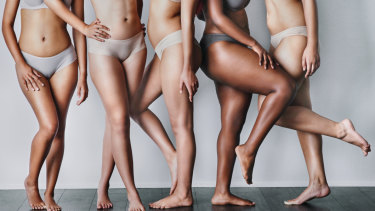You can’t ignore Tess Holliday. She has an amazing mane of red hair and the clearest skin you’ve ever seen, partially decorated with an impressive collection of tattoos. She is straight-up beautiful, and sassy to boot. Holliday is also “fat”, as she describes it, and has been in a place you would never expect to see a fat person. On the cover of a glossy magazine.
The American model is one of the heroes of the growing movement of body positivity. Holliday is not only a highly sought-after model (and not just in the plus-sized world), she has also created the online movement #EffYourBeautyStandards, a virtual finger in the air to the unrelenting beauty ideals to which women are subjected. This is somewhat ironic because while Tess is undoubtedly a beautiful woman, her social media accounts reveal huge numbers of people leaving disparaging comments about her appearance, particularly her weight.
Our focus should be on health behaviours – what we do, not what we look like.Credit:Getty Images
Either way, Holliday is one of a number of women who have decided to change the way we look at people’s bodies, with stunning results. These women of different shapes and sizes, ethnicities, sexual orientations and abilities are making an effort to shift public perceptions away from the traditional ideal of beauty.
People everywhere, and women in particular, have been subject to incredible pressure over their bodies, so it’s no wonder that these advocates for a kinder attitude have been so welcomed. However, with their popularity has come a barrage of criticism of body positivity, most notably for normalising obesity.
Holliday herself has engaged in public battles on social media with people who chastise her for promoting ill-health. Given that our hardline approach to demanding physical perfection has not worked, could this new, more inclusive and compassionate approach be better? Body positivity is a natural and probably necessary retaliation to traditional body-shaming, but if it doesn’t promote health, is it any better than other crusades, trends or norms?
Body image is a term that is thrown around a lot, but what does it really mean? Body image describes our perceptions and attitudes towards our physical appearance. Those times you have looked down at yourself and thought “big thighs” or “nice calves” are all part of your body image; your personal perception of what you look like and how you feel about your body. Body image changes over time, so how you feel as a teenager may evolve as you age. It can even change from day to day as things happen to you to make you feel differently about this wonderful vessel you get around in.
What is interesting, but not at all surprising, is that our own experiences or thoughts are more powerful than other people’s opinions of us. Our body image changes depending on our mood, whether we’ve exercised, and how we judge ourselves against some ideal or standard. Although others are more objective, what we see in the mirror, distorted or not, is uppermost in our mind. Despite reassurances from our friends, family or partners, we often do not believe them.
When we have preferences for body characteristics that are different from the ones we think we have, this is called body dissatisfaction. We develop these feelings about our body from life experiences, the culture we live in, the people close to us, teasing, our personality type and our beliefs about what bodies should be. All of these can lead to behaviours that perpetuate or even worsen such feelings.
As we are sold and internalise this idea of what an ideal body should be, a phenomenon called weight bias develops. Weight bias is a preference for slimmer bodies and gives rise to negative attitudes regarding bigger bodies. Weight bias leads to all kinds of negative consequences, including discrimination at work, in education and in healthcare.
The sad thing is that we can all internalise this weight bias and direct it towards our own bodies. Weight bias internalisation is related to body dissatisfaction but is a little different. It is when we take on board and believe these negative messages about weight. This isn’t just something bigger people do; a huge proportion of us internalise that thin is better and direct that towards ourselves in terms of what we think about our bodies and what we do to avoid gaining weight.
If body dissatisfaction and weight bias are the villain of this story, then body positivity claims to be our hero. Body positivity has sprung up in recent years, partly as an offshoot of the fat-acceptance movement, which aims to reduce many forms of stigma directed against people with obesity, from society at large to the medical profession. While fat acceptance is a movement purely for people with obesity, body positivity aims to be more inclusive and more conducive to overall health and wellbeing. In the online sphere, body positivity – or “BoPo”, as it’s often called – has amassed a huge following thanks to role models such as Holliday.
It’s important to understand that body positivity is not positive body image. Body positivity is more of a social justice movement, thanks in large part to its roots in fat acceptance and the drive to normalise how society sees and treats all kinds of bodies.
Positive body image is how we see ourselves in a compassionate yet realistic light with a degree of resilience. It’s an individual thing, while body positivity is for everyone and especially for those who have previously been excluded. The movement directly opposes the thin, fit, white ideal as being the only way to look and all of the messages and industries that sell us this notion.
Whether you are underweight, overweight or somewhere in between, problems with body image harm us all and keep perpetuating the idea that being skinny will bring you health and happiness. That kind of thinking probably won’t bring you skinny and it certainly won’t bring you happiness. Body positivity is a necessary and important part of our evolution towards finding a better way to promote health and ignore harmful messages we’ve been sent for years.
Scrolling through the Instagram posts of people such as Holliday reveals enormous goodwill towards the celebration of them as positive role models. But it also uncovers a host of people calling them names because they don’t find them attractive.
There is another group of people commenting on these photos, expressing concern for their physical health. In return, Holliday often posts back that they are healthy and are simply choosing to live a life that suits them and makes them happy.
Body positivity has also come under fire for its lack of inclusivity. While it arguably does a better job than the diet brigade, body positivity still tends to show women who are not so far from the accepted norm. There is still a tendency to focus on women who are white and traditionally beautiful, who are simply acknowledging their relaxed stomachs rather than being a genuine challenge to the norm.
Actor and activist Jameela Jamil is an outspoken critic of beauty norms and diets, yet she has received much criticism for daring to have such an opinion because she’s deemed slim, beautiful and extremely privileged. We need to call out body positive activists who aren’t inclusive but you seem damned either way. Say something and you’re too slim/beautiful to be allowed an opinion. Say nothing and you’re complicit/empowering the patriarchy/not checking your privilege.
Body positivity is there to accept everyone, yet it often falls into the traps that plague other movements. It is so frequently associated with showing bigger bodies that it forgets to show bodies that are disabled, of different ethnicities, that have stomas and scars, and so on. We are, once again, so focused on fatness versus thinness that we forget all those other people whose bodies don’t fit the norm. All social movements risk commodification and body positivity is no different.
The biggest criticism comes in the form of health concerns. Whether directed at the body-positive idol or society at large, many fear that body positivity promotes obesity and excuses behaviours that stop people becoming or staying healthy. Since our society is sinking huge amounts of time and money into fighting non-communicable diseases, it seems counterproductive or even dangerous for these kinds of messages to circulate.
The more we see larger people, the more we are likely to normalise these bodies, according to research. A UK study found that a high number of overweight or obese people perceived their weight as “about right”, although this study has been criticised for not looking at actual health measures.
Labelling children as “big” seems to correlate with weight gain throughout their life, while a large-scale Korean study showed physical health is threatened just by thinking you’re overweight, whether or not you are.
It will be interesting to see how this translates to health behaviours, because that’s where our focus should be – what we do, not what we look like.
Knowing we’re fat won’t make us thin. And thinking fat is okay won’t make us fat. Seeing Tess Holliday is not going to make you gain kilos, and watching a Victoria’s Secret show won’t make you lose kilos. Normalising bigger or different-looking bodies is not the worst thing in the world. Rather than categorising bodies, let’s begin to understand that we come in all kinds of shapes, sizes, colours and abilities and work with what we have.
This is an edited extract from Pretty Unhealthy: Why Our Obsession with Looking Healthy Is Making Us Sick (Murdoch Books) by Dr Nikki Stamp, on sale now.
This article appears in Sunday Life magazine within the Sun-Herald and the Sunday Age on sale September 22.
Source: Read Full Article






